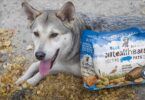Over 60% of pet owners admit to sharing human foods like grits with their furry companions without checking safety guidelines. While this Southern staple seems harmless, its suitability for pets requires careful evaluation. Grits, made from ground corn, often contain additives like butter, salt, or cheese that could harm canine health.
Veterinarians emphasize that nutritional needs differ vastly between species. What fuels humans might overload pets with unnecessary carbohydrates or sodium. Plain, unseasoned grits in small quantities occasionally pose minimal risk. However, regular feeding could disrupt balanced diets designed for dogs.
Pet nutrition studies reveal that 34% of gastrointestinal issues in canines stem from inappropriate human foods. Common concerns include artificial flavorings and high-fat toppings mixed into grit-based dishes. Owners should prioritize vet-approved meals over table scraps, even when sharing seems harmless.
Before offering any new food, consulting a trusted veterinarian remains crucial. They assess individual health factors like allergies, weight management needs, and digestive sensitivities. This proactive approach helps maintain optimal wellness while satisfying a pet’s curiosity about human meals.
Understanding Grits: Origins and Nutritional Profile
Southern cuisine celebrates grits as a versatile base for countless dishes. This staple traces its roots to Native American communities who first processed corn into coarse meal. Modern versions use ground corn kernels to create the familiar creamy texture many enjoy today.
Nutritional Components of Grits
A half-cup serving of plain grits contains 15g carbohydrates and 1g fiber. They provide small amounts of iron and B vitamins. These nutrients support energy production but lack the protein and fats pets require.
Traditional Preparation and Variations
Classic recipes often mix grits with butter, cheese, or salt. These additions boost flavor but increase fat and sodium content. Holiday versions might include heavy cream or bacon grease, creating richer dishes unsuitable for animals.
While grits offer basic nutrition, they don’t meet the dietary needs of canines. Their carbohydrate-heavy profile contrasts with species-specific requirements for meat-based proteins. Always check ingredient lists before considering shared meals.
Assessing the Benefits and Risks for Your Dog
Pet owners often face tough choices when deciding which table foods might suit their companions. While some ingredients offer nutritional value, others could compromise animal health. This evaluation focuses on grits’ potential advantages and drawbacks in canine diets.
Potential Health Benefits and Digestive Fiber
Plain grits contain soluble fiber that supports digestive regularity. A small portion might help pets with occasional constipation. However, fiber requirements vary based on breed size and existing dietary habits.
Risks from Additives and High-Carbohydrate Content
Seasoned versions often include ingredients harmful to animals. Excess sodium from salted butter or cheese toppings strains kidneys. High-carb meals may contribute to weight gain if fed regularly.
Corn-based dishes lack sufficient protein for muscle maintenance. Essential nutrients like omega fatty acids remain absent in most recipes. Always prioritize species-specific formulas over temporary fixes.
Consulting a veterinarian helps identify individual sensitivities. Some animals process grains better than others. Personalized guidance ensures balanced nutrition while minimizing health risks.
Can Dogs Eat Grits? A Detailed Look at Safety and Nutrition
When considering adding new items to a pet’s meals, understanding both safety and nutritional value becomes paramount. Grits, while not toxic, require careful evaluation of individual factors like digestive health and dietary balance. Owners must weigh short-term curiosity against long-term wellness goals for their companions.
Evaluating Allergies and Digestive Tolerance
Corn-based ingredients trigger reactions in some pets. Signs like itching, vomiting, or diarrhea may indicate sensitivity. Monitoring behavior after initial tastings helps identify adverse responses early. Veterinarians recommend introducing tiny amounts spaced 48 hours apart to isolate potential issues.
Proper Portion Sizes and Feeding Guidelines
A teaspoon per 10 pounds of body weight serves as a safe starting point for occasional treats. Never exceed 5% of daily caloric intake from non-core foods. Unseasoned preparations avoid harmful additives like butter or salt that strain organs.
Essential nutrients in commercial diets far outweigh the limited benefits of cornmeal. Consult a veterinarian to assess how grits might fit into specific health plans. They can address concerns about weight management or nutrient deficiencies through tailored advice.
Prioritize high-protein meals over carbohydrate-heavy options. While minimal grits pose low risks, frequent servings could displace vital nutrients from balanced formulas. Always pair human-food experiments with professional guidance for optimal safety.
Alternative Foods and Complementary Supplements for Dogs
Pet nutrition thrives on variety, but selecting appropriate ingredients matters more than novelty. While occasional human-food treats might seem tempting, species-specific formulas deliver balanced nourishment without risks. Focus on vet-approved ingredients that align with natural dietary needs.
Exploring Lean Proteins and Dog-Friendly Grains
High-quality proteins form the foundation of healthy meals. Chicken, turkey, and salmon provide essential amino acids for muscle health. Pair these with digestible grains like oatmeal or quinoa for sustained energy. Vegetables like carrots and green beans add vitamins without unnecessary calories.
Commercial foods meeting AAFCO standards simplify nutrition planning. These products undergo rigorous testing to ensure complete profiles. Rotating protein sources prevents boredom while maintaining dietary balance.
Overview of Recommended Supplements
Supplements address specific needs that base diets might miss. Puppy Ultimate Health Chews support growing joints and cognitive development. Senior Dog Ultimate Health Chews target aging concerns like mobility and digestion. Always consult a veterinarian before adding new products.
Combining whole-food ingredients with targeted supplements creates robust meal plans. This approach reduces reliance on less suitable options while promoting long-term wellness. Trustworthy brands and professional guidance make optimizing pet nutrition straightforward.
How to Prepare Grits Safely for Your Dog
Proper preparation transforms this Southern staple into an occasional treat. Focus on simplicity to avoid harmful additives while preserving nutritional value. Start by selecting the right ingredients and mastering safe cooking techniques.
Choosing Plain, Unseasoned Grits
Always opt for unflavored varieties without added salt or seasonings. Check labels for hidden ingredients like cheese powder or artificial flavorings. Stone-ground versions retain more natural fiber than instant options.
Water works better than milk or broth for cooking. Avoid butter and oils that add unnecessary fats. Plain preparations minimize digestive upset while maintaining beneficial fiber content.
Cooking Tips for Optimal Consistency
Use a 4:1 water-to-grits ratio for easy digestion. Stir frequently to prevent clumping and ensure even texture. Cook until creamy but not overly thick, which aids nutrient absorption.
Cool servings to room temperature before feeding. Test a pea-sized portion first to monitor tolerance. Store leftovers in airtight containers for up to three days.
Pair small portions with protein-rich foods for balanced snacks. Consult your veterinarian about frequency and serving sizes tailored to your pet’s needs. This approach maintains dietary harmony while satisfying occasional curiosity.
Understanding Corn’s Role in a Dog’s Diet
Corn ranks among the most common ingredients in commercial pet foods, yet its nutritional value sparks ongoing debates. This versatile grain provides energy through carbohydrates but raises questions about processing methods and allergen potential. Let’s examine how corn contributes to canine nutrition and where caution applies.
Benefits of Corn as a Source of Carbohydrates
Ground corn offers easily digestible carbohydrates that help fuel active pets. Whole kernels contain fiber supporting gut health, while processed forms provide quick energy. Many veterinary nutritionists approve corn in moderation as part of balanced meals.
The grain delivers essential nutrients like linoleic acid and antioxidants. These compounds promote skin health and immune function. When properly prepared, corn serves as a cost-effective energy source without spiking blood sugar levels excessively.
Concerns Over Allergies and Processing Methods
Some animals develop sensitivities to corn proteins, triggering itching or digestive upset. Veterinarians estimate 10-15% of food-related allergies in pets stem from grain ingredients. Always monitor for reactions when introducing corn-based foods.
Highly processed versions lose nutritional value during manufacturing. Cheap fillers in low-quality diets may displace protein-rich ingredients. Opt for products using whole-ground corn and clear processing standards to maintain dietary benefits.
Consult your vet about corn’s role in your pet’s specific meal plan. They can recommend appropriate portions and identify better alternatives if needed. Balanced nutrition always outweighs temporary convenience.
Final Thoughts on Balancing Diet and Canine Health
Balancing a pet’s diet requires understanding both nutritional value and species-specific needs. While occasional grits might seem harmless, they lack essential nutrients for long-term health. Focus instead on vet-approved meals that meet dietary requirements through balanced proteins, fats, and vitamins.
Consulting a veterinarian remains critical when introducing new foods. They assess individual factors like allergies and weight management to prevent health risks. Supplements and high-quality formulas often provide better benefits than temporary table scraps.
Prioritize complete formulas designed for pets. These provide balanced nutrients without unnecessary fillers. Pair them with lean meats or digestible grains for variety. Always monitor portion sizes to avoid calorie gain while maintaining nutritional goals.
Smart dietary choices build lifelong wellness. Trust professional guidance over trends, and let your pet’s unique needs guide meal planning. With thoughtful nutrition strategies, you’ll support their vitality without compromising safety.
FAQ
Are grits safe for pets to consume?
Plain, unseasoned grits are generally safe in moderation. However, avoid additives like butter, salt, or cheese, which can cause digestive upset or long-term health issues. Always consult a veterinarian before introducing new foods.
What ingredients in prepared grits could harm a dog?
Garlic, onion, excessive sodium, and dairy products like butter are common additives that pose risks. These may lead to toxicity, dehydration, or lactose intolerance symptoms. Stick to basic recipes without spices or flavorings.
How much grits can a dog eat without health concerns?
Small portions (1-2 tablespoons for medium-sized pets) occasionally are acceptable. Overfeeding may contribute to weight gain due to high carbohydrate content. Balance meals with lean proteins and vegetables for optimal nutrition.










Leave a Comment